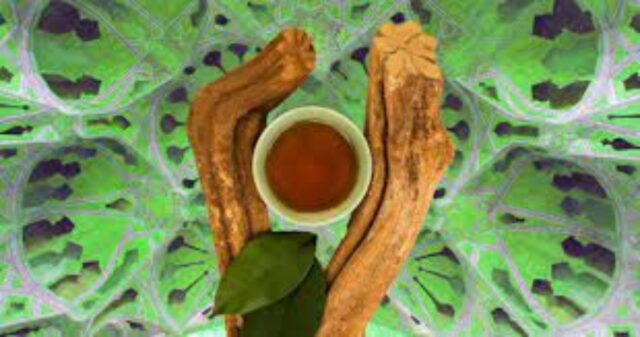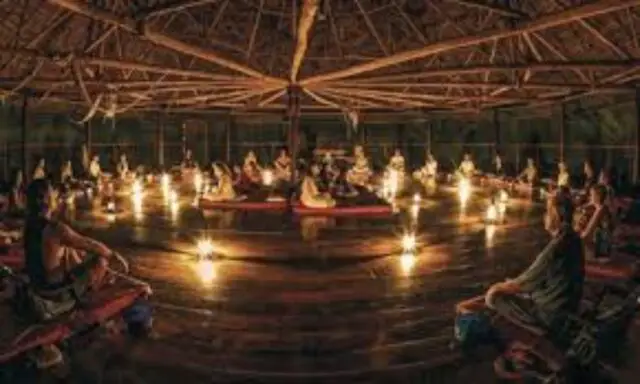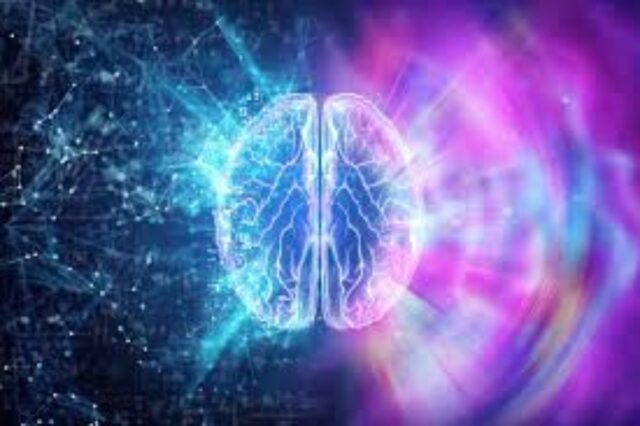For thousands of years, people belonging to the indigenous peoples of the Amazon have ingested a mystical and powerful brew of plant origin called ayahuasca. It is often drunk during ceremonies carefully curated by plant medicine facilitators or shamans. The effects of ayahuasca are often intertwined with immense healing and deep spirituality.

Although the history of the origin of ayahuasca has been forbidden by the passage of time and the lack of archaeological evidence, the various traditional shamanic rituals that guide the use of this plant-based concoction are still not only important, but necessary, for the experience. .
Over the course of a few decades, ayahuasca has spread beyond the confines of indigenous communities scattered throughout the countries of South America. Tourists from all over the Western world flock to ayahuasca retreats in countries like Peru, Costa Rica, and Brazil for healing and a greater sense of their own spirituality. Despite the long tradition in the use of this medicinal plant, the concrete benefits of ayahuasca are coming to light through the lens of science.
How exactly can this herbal medicine benefit your life? Before attempting to tie together the scant research with centuries of traditional healing to unearth the benefits of ayahuasca, let’s first explore what ayahuasca is and how the experience comes about.
What is ayahuasca?
Originally from South America, ayahuasca is a psychotropic drink traditionally used for religious and healing purposes by the indigenous peoples of the Amazon. It is typically made from an amalgam of two main plant-based ingredients: Banisteriopsis caapi and Psychotria viridis.
The psychoactive component of the drink is typically a shrubby plant called Psychotria viridis, which in some cases is replaced by Psychotria carthagenensis or Diplopterys cabrerana. The leaves of this plant contain the hallucinogen DMT, extraordinarily dynamic and with a great mental effect.
Banisteriopsis caapi is a vine that doesn’t actually create any psychedelic effects, but is used as an MAOI, or monoamine oxidase inhibitor. Our bodies naturally contain the enzyme MAO in the stomach, which would prevent DMT from reaching the bloodstream. Without the MAO inhibitor, DMT would be broken down by these enzymes in the liver and would dampen the psychedelic and spiritual experience.
Usually, the ingestion of ayahuasca, often referred to as the “spirit of the plant,” launches the individual into an enigmatic realm that reflects the wisdom and harmony of Mother Earth in many ways. Commonly known as “realms,” these powerful hallucinations tend to help people unravel past traumas that have been suppressed. This allows them to return to their normal state of consciousness with a reinvigorated view of everyday life.
“When we ingest this medicine we are entering another dimension, and in that kingdom there are things that are not familiar to us,” say Costa Rican wellness retreat experts, where ayahuasca ceremonies are held. “There are things that we do not deal with on a daily basis. We see things that are real, but that are not in our normal conscious reality.”

The ayahuasca ceremony
The details of the session are entirely up to the shaman or plant medicine facilitator guiding the topic. Each ayahuasca ceremony is tailored to the specific group “sitting” that night, and the specific facilitator leading the way.
This personalized approach is developed after examining the visitors. The program and the size of the group depend on the experience and mental state of each individual. The duration and details of the ceremony also depend on the retreat and the traditions exposed by the shaman or facilitator.
The standard program consists of four ceremonies usually integrating around three ayahuasca ceremonies in its program. It also includes mindful activities like nature walks and yoga. Still, this is subject to change depending on the group and the plant facilitator.
Aside from the ceremony itself, each program also includes specific guides for preparation and integration. During the weeks leading up to the ceremony, participants are asked to follow a strict diet that varies according to the ritual. It is also common for participants to abstain from alcohol, nicotine, caffeine, and sex to prepare the body for the experience.
Benefits of ayahuasca for depression, anxiety, post-traumatic stress and addictions
Despite the highly specific tradition surrounding this psychedelic plant, the ayahuasca experience has benefited people from all walks of life. This medicinal plant has proven to be particularly effective for those who suffer conditions like depression and PTSD (post traumatic stress syndrome). There is a good deal of research that scratches the surface of these benefits. Additionally, there are many anecdotal accounts of participants experiencing life-changing effects of ayahuasca.
“Medicine will illuminate the roots of everything that is causing dissonance in your life. And it will also help you heal,” say the facilitators. “There is a purgative aspect of medicine that takes us through releasing these really deep emotional blocks. These are the source of our depression or anxiety or whatever it is that we are trying to cure.”
Here’s a closer look at what the existing research and experts have to say about the benefits of ayahuasca for depression, anxiety, PTSD, and addiction treatment:
For depression and anxiety
Early scientific evidence seems to support the belief that ayahuasca could be a useful tool for fighting depression. A recent study published in March 2019 found that ayahuasca might help with treatment-resistant depression. The double-blind randomized trial involved 29 patients. Some were given a single dose of ayahuasca, and others a placebo. The results showed that ayahuasca produced significant antidepressant effects compared to placebo.
Other research has examined ayahuasca’s ability to modulate cortisol levels. This hormone produced by the adrenal glands regulates emotional and cognitive processes. Cortisol levels are believed to play an important role in the onset of depression. For this reason, regulating it properly has become a crucial aspect of treatment. Recent findings suggest that ayahuasca could modulate salivary cortisol levels. Once again, this shows its potential value as a natural antidepressant.
In another study in which 57 attendees of the ayahuasca ceremony were observed in the Netherlands and in Colombia, it was found that the rates of depression and stress decreased dramatically after the ceremony. These effects also persisted for four weeks. Interestingly, the researchers found a correlation between the magnitude of the dissolution of the ego and the level of satisfaction with life, consciousness and general changes of the individual.
As a treatment for PTSD
Little available evidence also shows this medicinal plant as a useful tool for PTSD patients. In a study published in April 2018, researchers postulated that the effects of ayahuasca may target traumatic memories and provide healing for PTSD patients.
The researchers behind this study claim that DMT, one of the alkaloids found in ayahuasca, activates sigma 1 receptors (SIGMAR1). This multifaceted stress-sensitive receptor promotes cell survival, neuroprotection, neuroplasticity, and neuroimmunomodulation. As MAO Is prevent the breakdown of DMT, this appears to allow PTSD patients to regain repressed memories, making them easier to identify and alter.
As is customary with psychedelics, more research is needed to understand the full scope of how ayahuasca interacts with 1-sigma and other receptors. But this particular study can be supported by anecdotal experiences that many have had ayahuasca ceremonies. Still, it is important to note that this herbal medicine should not be treated as a cure-all. Rather, it should be viewed as a specialized tool, within a toolbox that includes therapy and other healing modalities.
“Many times, people with depression or PTSD are not necessarily going to get a miracle cure from the ayahuasca ceremony,” says the director of Posada’s medicinal plants program, who preferred to remain anonymous. “You have to put in the proper context that ayahuasca can be something that can be enormously beneficial, but it works best when combined with other types of support.”
For the treatment of addiction
Multiple studies have also shown that ayahuasca could be a useful tool in the fight against addiction to substances such as alcohol, cocaine, and nicotine. When it comes to research, the apparent value of ayahuasca for addiction treatment may have the strongest scientific backing of all the mental conditions mentioned.
A 2014 study included interviews with therapists who administered ayahuasca for addiction treatment and 14 people who underwent such treatment. Researchers found that ayahuasca could support recovery and prevent relapse when taken in “carefully structured settings.”
Another report looking at ayahuasca-assisted treatment for substance abuse within a Native Canadian community in British Columbia reached a similar conclusion. He noted that the subjects showed positive behavioral and psychological changes after undergoing ayahuasca-assisted therapy.
Although scientific evidence remains relatively sparse, this has not stopped people struggling with substance addiction and other mental conditions from reaping the (anecdotal at least) benefits of ayahuasca ceremonies.
An artist and healer who participated in an ayahuasca ceremony says that the experience has reshaped his views on alcohol use. Although he never considered himself to have a serious problem with alcohol, the plant medicine helped awaken his true calling. It required him to change his drinking habits to reach his own personal potential.
“The great epiphany I had with ayahuasca was about alcohol. He drank normally like anybody drinks. But I had this overwhelming feeling of knowing that the light that I was meant to spread in this life was being hampered by alcohol, ”he explains. “That experience with ayahuasca was a change of course. I completely lost interest in alcohol. “
Brain health
There is also some scientific knowledge that shows that certain components of ayahuasca can offer neuroprotective and neurore-restorative properties, already noting how DMT appears to activate sigma 1 (SIGMAR1) receptors and improve cell survival, neuroprotection, neuroplasticity and neuroimmunomodulation. Similarly, in a test-tube study that looked at the effects of DMT on human brain cells, DMT increased cell survival and protected brain cells from damage caused by lack of oxygen.

It’s not just the DMT in ayahuasca that seems to promote brain health. Also the alkaloids of the main ingredient Banisteriopsis caapi could play a role. A 2017 study in animals showed that the main alkaloids found in this vine stimulated the proliferation, migration and differentiation of neural stem cells in the brains of adult mice. Modulation of brain plasticity could contribute to the apparent antidepressant effects of ayahuasca.
Additionally, the natural alkaloid harmine β-carboline, which is abundant in Banisteriopsis caapi, has been examined in preclinical studies for its neuroprotective and cognitive-enhancing effects. It also improved memory and learning ability in different animal models. In general, researchers have called for harmine to be further evaluated in preclinical and human studies.
General well-being
Even if there is no tangible condition being treated, participants in the ayahuasca ceremony can still experience immense benefits from the plant medicine, particularly when it comes to improving their overall well-being.
This improved well-being could be especially helpful for people suffering from physical conditions like cancer. In a 2018 comparative study, four session. Weekly ayahuasca appeared to increase awareness and acceptance more than an eight-week awareness training program.
On a spiritual level, ayahuasca has been praised for its ability to magnify spirituality. This has been observed even in people who are not particularly connected to that side of themselves. Whether you’re looking for a spirit guide or just curious to take the psychedelic, the resulting journey is often shocking and life-altering. People have come out prepared to leave unsatisfying careers behind or ready to change other aspects of their lives.
Acceptance and awareness
Ayahuasca can be very enlightening in giving someone a perspective on their spiritual life as a whole. It does not matter what tradition the person belongs to, or if it is not part of a tradition at all, it can be very enlightening to find your own path, to find your own sense of direction, your own sense of relationship of what is important in that aspect of your life.
Risks of ayahuasca (and how to avoid them)
The immeasurable benefits of ayahuasca are being brought to an increasing number of people. But there are certainly risks that need to be considered. On a bodily level, the ayahuasca ceremony can sometimes induce temporary episodes of vomiting, diarrhea, and even paranoia.
Certain medications can also have adverse interactions with this herbal concoction. This is especially true in the case of those that have a direct impact on the serotonergic system, such as antidepressants. In many ayahuasca retreats, participants will be asked to cut back on SSRIs, or to stop taking other medications.
Research has also shown that high doses of ayahuasca may increase heart rate and blood pressure. This could be potentially dangerous for someone with a heart condition. People with a history of schizophrenia or other psychiatric disorders should avoid ingesting ayahuasca. This is because the plant could make psychiatric symptoms worse.
Still, reports of fatal or life-threatening reactions from ayahuasca patients appear to be rare. However, that doesn’t mean you should ingest this plant without proper planning and guidance. Danger may arise if the plant facilitator or shaman is untrained or careless about dosage and orientation.
An ayahuasca session can introduce someone to hellish realms and entities that are not exactly safe. But with proper preparation, these so-called hell realms can be incredibly powerful and lead to life-altering benefits. However, there is a risk of not being prepared for these potentially terrifying realms. Therefore it is crucial to attend an ayahuasca ceremony with a highly experienced and trustworthy plant facilitator or shaman. This will not only ensure a safer experience, but also a more effective one.
But you can experience a hellish realm with the right guidance, and it is truly therapeutic and healing. Because the realm of healing is within you, you step into your own shadow. There is gold there that can be transmuted and integrated so that you can live a better life or to your full potential .
The importance of a good guide
It is not just the traditional psychedelic motto of “setting” that needs to be fulfilled when consuming ayahuasca. There seems to be universal agreement that having an experienced guide is the key to unlocking the full potential of the experience. Also, it’s crucial to vet your guide with a series of questions, like the ones listed here, to make sure they have harm reduction expertise and ability.
An expert healer will be able to receive the information of the spirit through the opening of this portal that opens in the work of medicine, receiving the necessary information for each person. A good facilitator is not one who does something specific, but one who is capable of being a channel as clear as possible so that the divine can flow through them.
It is clear that ayahuasca can provide immeasurable benefits to many, many people, whether they are seeking a psychedelic experience or need help to overcome difficult mental struggles. But the main conclusion from all the research and anecdotal reports collected is that this herbal medicine should be taken safely and respectfully with a trusted and experienced plant shaman or facilitator.


